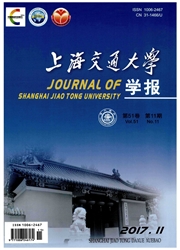

 中文摘要:
中文摘要:
提出一种空时网格码(STTC)码字设计思想,在发射信号之间引入确定的空间和时间关联性,并设计了一种称为反馈-干扰抵消检测的新解调方法.该方案在保证频谱利用率不变的情况下,使得接收端在解调时仅对少数信号进行最大似然判决,取代了传统的最大似然序列估计方案,大大降低了STTC的译码复杂度.在理论分析中,推导了传统解调方案和新解调方案的计算复杂度并进行了比较,随着编码器约束长度的增长,反馈-干扰抵消检测方案在计算复杂度上的优势将更加明显.在此基础上,对发射天线数为2和3时的情况,提出了具体的编译码范例并进行了仿真.仿真结果表明,所提出的解调方案具有在天线相关时保证误码性能不降低的优点.
 英文摘要:
英文摘要:
Space-time trellis code (STTC) provides two gains: diversity gain and coding gain. So it has an excellent error rate performance. But conventional STTC utilizes maximum likelihood sequence estimation (MLSE) ,specially Viterbi algorithm ,for decoding at the receiver, searching the best paths in the trellis. The high computational complexity restricts the application of STTC. This paper designed the encoding trellis of STTC, introducing fixed spatial and temporal correlation into transmitted signals, and utilized a new method called Feedback and Interference Cancellation Detection (FICD) for demodulation. The spectral efficiency is maintained and the computational complexity of demodulation is much lower, for ML detection is adopted among a small number of signals. The theoretical analysis provides the computational complexity formulas for both schemes. When the constraint length of encoder increases, the advantage in computational complexity of FICD scheme is more obvious. Simulation results of the paradigms were shown when the number of transmit antennas is 2 and 3. Under the condition of correlated antennas, the FER performance does not deteriorate, which is impossible for the conventional STTC with MLSE.
 同期刊论文项目
同期刊论文项目
 同项目期刊论文
同项目期刊论文
 期刊信息
期刊信息
